Ferritin-Blog
Ferritin-Blog

Ferritin Assay
Ferritin, a protein but also an indicator of the body’s iron levels and stores is valuable when tested alongside other proteins and lipids to identify the function of muscle metabolism, transporting oxygen and DNA synthesis.
Anaemia is the cause of iron deficiency, a shortage of red blood cells resulting in the stores being inadequate in meeting the necessary needs for metabolism. Literature has identified that this could be the result of haemolysis and excessive bleeding. Testing regarding Ferritin, renal function and glucose are used to determine the sole cause of anaemia. Some symptoms of this deficiency include extreme fatigue, decreased productivity, diminished physical performance and significantly reduced immunity. However, in stark contrast having an over accumulation of iron in the body can be the result of hereditary disorders of haemochromatosis and thalassaemia.
Iron seeks to bind with a protein as it’s very reactive as a biomarker, so while being stored in cells iron binds to Ferritin, this in turn makes Ferritin an ideal predictor of iron reserves. Toxicity from elemental iron causes tissue damage and collates free radicals. Excess iron collated in the body over time causes serious damage to the liver and vital organs, causing liver failure, cirrhosis, skin pigmentation, heart failure and arrythmia. There is no way to eliminate excess iron from the body, so regulation of iron stores is vital to check of changes in iron absorption. As Ferritin is the primary iron storage, without it iron levels cannot be regulated and can cause serious damage.
Ferritin itself is produced on a very small level before being released in the bloodstream. During inflammation episodes, due to infections, rare conditions or even obesity, Ferritin levels can become significantly elevated. It poses as a challenge to accurately diagnose iron deficiency and can unfortunately lead to a misled evaluation regarding the possible overload of iron. This issue is being worked on to resolve and be able to accurately measure iron levels while inflammation is present. CRP may also be used as an aid to help rule out the elevated Ferritin levels from the cause of inflammation.
Ferritin is described as ‘an intracellular hollow protein’, comprised of around 4500 iron atoms within the iron core, surrounding the core are 24 subunits. In contrast, a reduced Ferritin level in serum indicates a deficiency and or depletion of iron stores, however it may not determine advanced depletion.
Randox Laboratories offer an accurate Ferritin Assay, used to detect iron levels and aid in the diagnosis and treatment of conditions such as anaemia.

‘Benefits of the Ferritin Assay include’.
Wide measuring range of 5.08 – 443 mg/dl for the accurate detection of clinically important results
Automated immunoturbidimetric assay eliminating the need for any dedicated equipment.
Liquid ready-to-use reagents for convenience and ease-of-use
Stable to expiry when stored at +2 to +8°C.
Applications available detailing instrument-specific settings for the convenient use of the Randox Ferritin assay on a wide range of biochemistry analysers
Complementary controls and calibrators offering a complete testing package.
Some clinical points to note include. Ferritin has been observed in 89% of patients with Adult-Onset Stills Disease, there have been elevated Ferritin levels of five times the normal range in over half of patients with this disease. COVID-19 critically ill patients experienced elevated concentrations, along with Sepsis patients that are not recovering also experience a stark increase in their Ferritin levels.
Click the link below to find out more on our Ferritin Assay!
References
Fernandez-Alvarez R, Gonzalez-Rodriguez AP, Gonzalez E, Rubio-Castro A, Dominguez-Iglesias F, et al. Serum Ferritin as Prognostic Marker in Classical Hodgkin Lymphoma Treated With ABVD-based Therapy. Leukemia & Lymphoma . 2015;56(11):3096-3102.
Randox (2023) Ferritin: Reagents, Randox Laboratories. Available at: https://www.randox.com/ferritin/ (Accessed: 20 September 2023).
Rosário C, Zandman-Goddard G, Meyron-Holtz EG, D’Cruz DP, Shoenfeld Y. The hyperferritinemic syndrome: macrophage activation syndrome, Still’s disease, septic shock and catastrophic antiphospholipid syndrome. BMC Medicine . 2013;11(185).
Sharma J, Sharma R. A prognostic marker in patients with sepsis in pediatric age group: A prospective cohort study. International Journal of Medical and Health Research . 2018;4(3):86-89.
The Royal College of Pathologists. Guidance on the Use and Interpretation of Clinical Biochemistry Tests in Patients with COVID-19 Infection.; 2020. Accessed September 18, 2023. https://www.rcpath.org/uploads/assets/3f1048e5-22ea-4bda-953af20671771524/G217-RCPath-guidance-on-use-and-interpretation-of-clinical-biochemistry-tests-in-patients-with-COVID-19-infection.pdf
World Health Organisation. WHO Guideline on Use of Ferritin Concentrations to Assess Iron Status in Individuals and Populations.; 2020. Accessed September 18, 2023. https://www.who.int/publications/i/item/9789240000124
From Fear to Freedom: A QC Data Management Revolution
What if we told you we had a solution to the multitude of monotonous hours spent analysing reams of IQC data and could provide you with an intuitive tool packed with comprehensive and customisable reports, interactive charts, and automated statistical analysis to help improve your QC data management?
Perhaps it sounds too good to be true?
This time, it isn’t.
Uncertainty of Measurement. 6Sigma. QC Multi-rules. These words can strike fear into the hearts of even the most experienced laboratory staff.
With Acusera 24.7, we’ve reached under the bed and forced the monster that is advanced statistical analysis out into the cold.
Acusera 24.7 is a live, cloud-based, interlaboratory QC data management and peer group comparison software.
A mouthful. I know.
But let’s break it down
A live, cloud-based software means you can access your QC data from anywhere, anytime.
Bid farewell to the labyrinth of folders you hunt through when troubleshooting or looking for a specific dataset.
Interlaboratory management describes the momentous task many QC managers face – monitoring the QC performance of multiple laboratories in different locations, ensuring they all maintain the high standards required for accreditation and accurate patient results.
Unlike some big-name subscription services, we encourage you to use our software at different locations to help you monitor all your laboratories and instruments to see how their results stack up against one another.
Acusera 24.7 provides multiple levels of access which are completely customisable. This allows you to grant or restrict access to different parts of the software depending on what is required by your staff. This also allows QC managers to view data from all their sites in one location without needing multiple email chains from each laboratory.
Peer group comparison? Isn’t that what EQA is for?
Well, you would be right.
Yes, EQA does provide a comparison with your peer group, but it doesn’t have exclusive rights.
There are many benefits to comparing your IQC data with your peer group. The real-time comparison data aids with troubleshooting, or you can show off how great you are to your friends and colleagues.
You can select your peer group for an instrument, method and more, providing you with a comprehensive picture of how your laboratory performance compares to your peers using the same lot of control.
There are no submission deadlines. One less thing for you to worry about.
Still think it sounds too good to be true?
Then let’s look at some of the software features and how they can be used to make your daily QC data management easier.
Charts
For many laboratories, review of their QC data is a momentous task involving an abundance of printouts with different data tables and graphs and hastily scribbled notes going back maybe months, if not years.
With Acusera 24.7’s interactive Levey-Jennings charts, you can see the QC data from a specified date range. This helps visualise trends and biases over any period to simplify the troubleshooting and lot validation processes, or, can be used as evidence during accreditation assessments. These charts can be generated for a single analyte or for multiple analytes and QC levels.
You can also add events to the graph to record factors that might impact the performance of your analyser such as preventive maintenance, calibrations or switching QC lots. So, when you come to review the QC data and see a shift in the results, you can see at a glance if there was an explanation for the change in QC results.
What’s more, the points plotted on the chart will appear in orange or red if they trigger your alert or reject protocols respectively. Those that appear as a triangle indicate a comment is attached. Comments can be added to any data point directly on the Levey-Jennings chart, allowing you to record any information relevant to the data, saving you time, not to mention the cost of all those sticky notes.
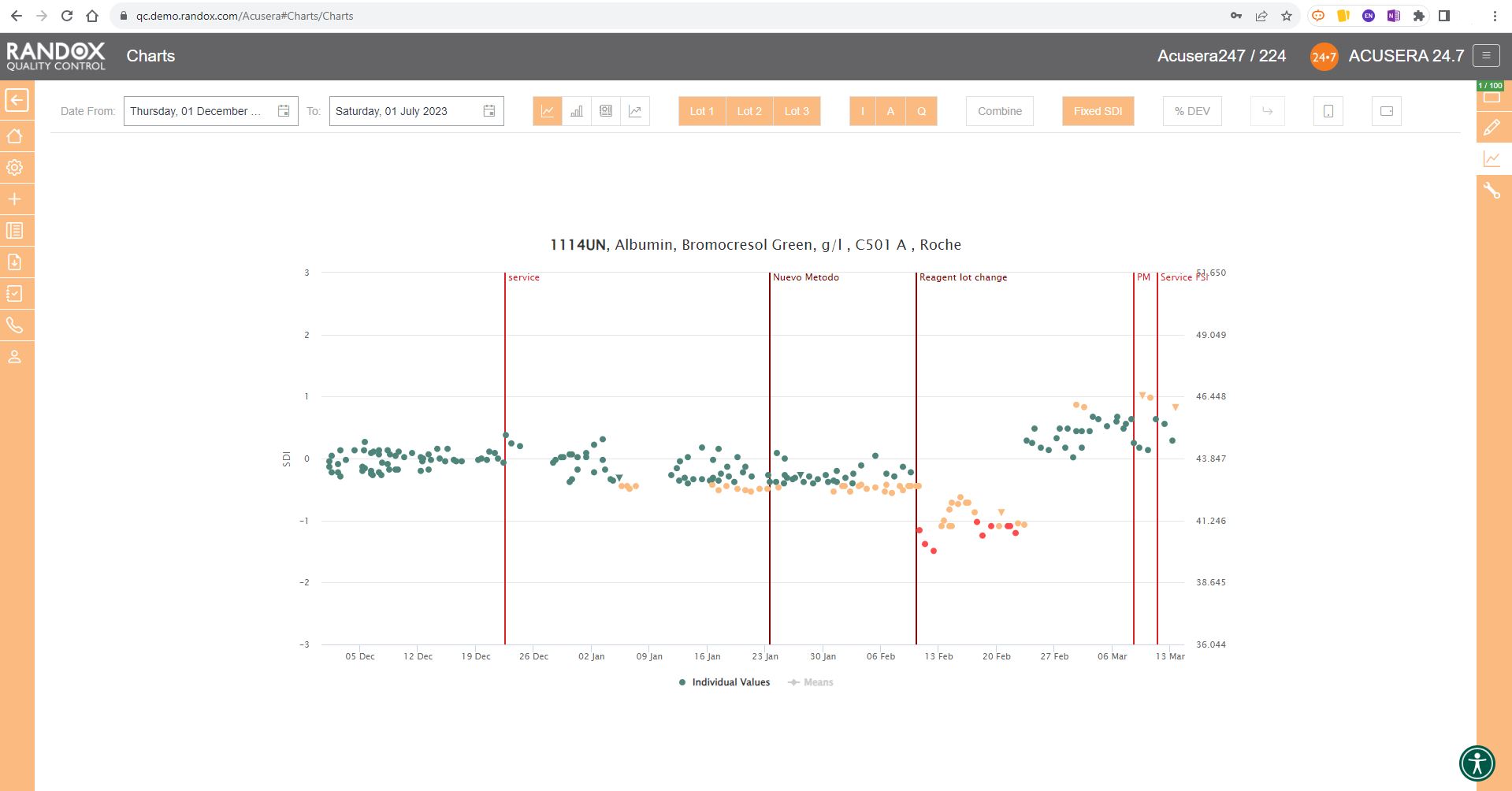
This complements the Panel feature of the software. Within Acusera 24.7 you can create a panel of tests, for example, a Liver Function Test panel, grouping all the tests together. You can then view all the QC data for this panel at the click of a few buttons. Shown below is the collective data for a clinical chemistry panel.
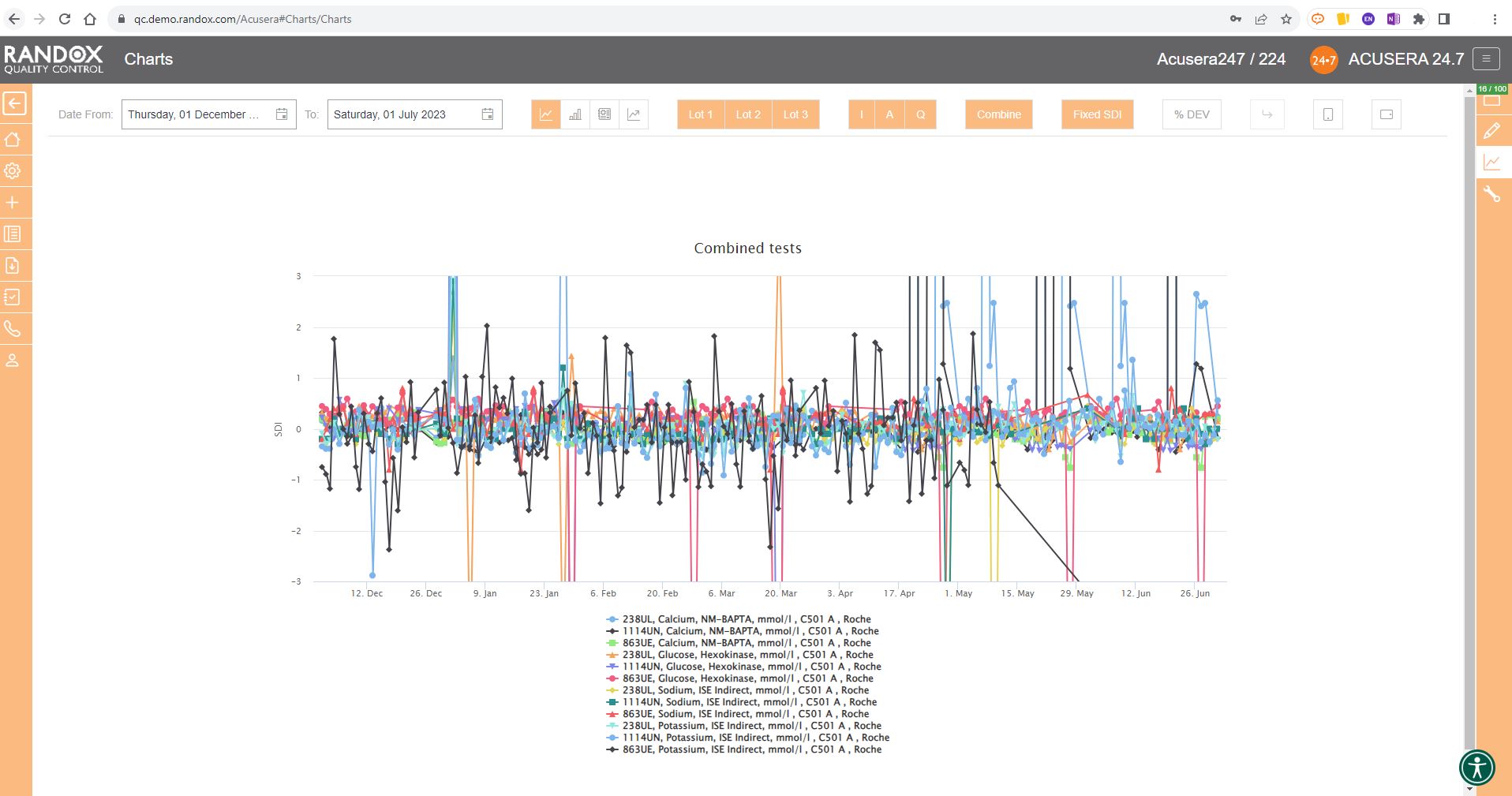
When you do need the paper copy, all the charts and reports found in Acusera 24.7 can be exported to Excel or PDF for independent analysis or printing, making it easy to bring your data to meetings or for hardcopy filing and audits.
For peer group comparison, you can get a performance summary chart. This chart basically does the analysis for you! You define the date and time range, and the software looks at all the data points within it for you and your peer group, comparing individual data, means, CVs and SDs. Like our other charts, you can combine any number of these for multi-analyte analysis.
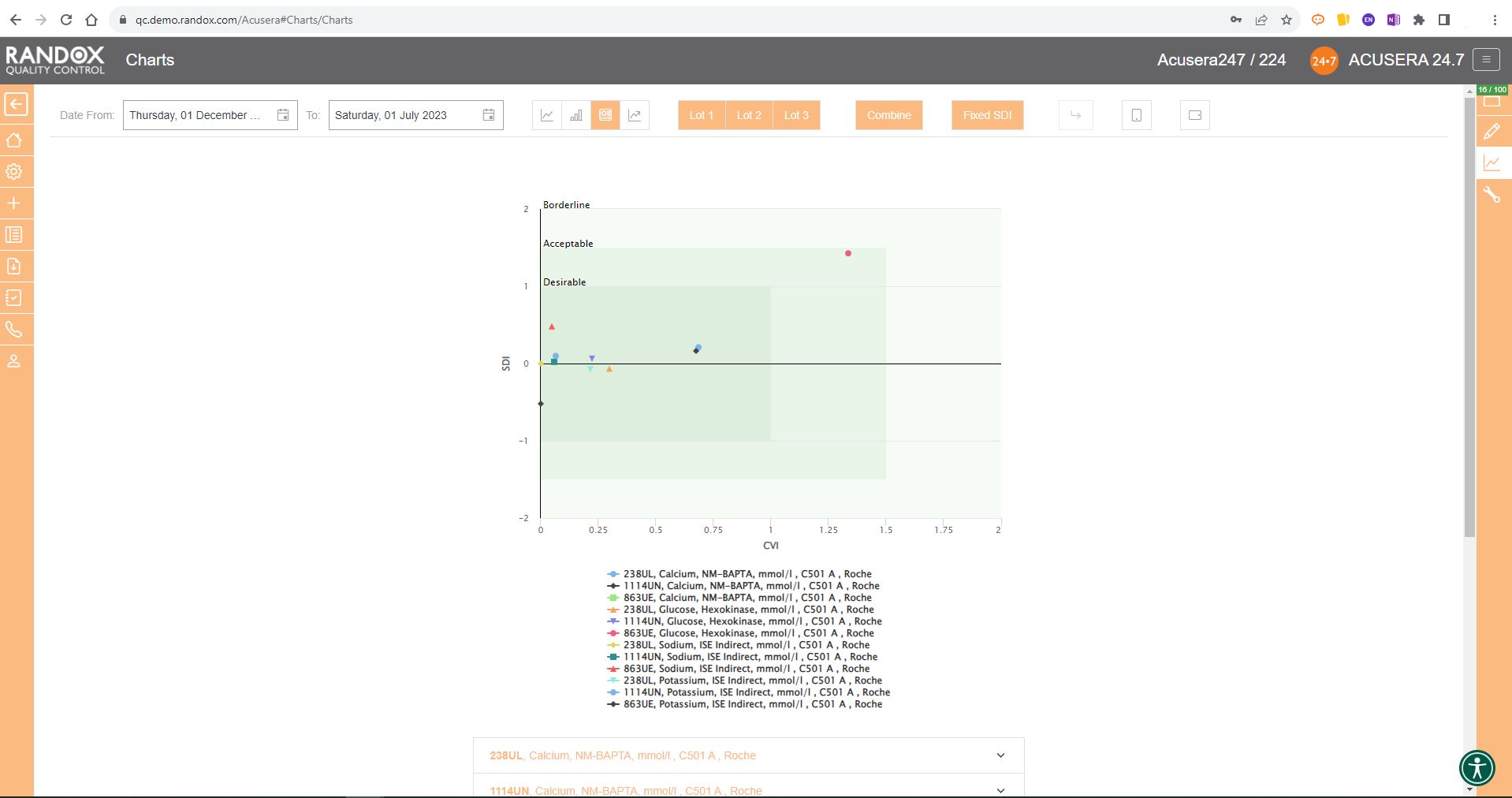
Advanced Statistics
Some people love statistics. Others can think of nothing worse.
Either way, there’s a lot of work involved in advanced statistical analysis.
Even if you’re in the love camp, you might find yourself sickened before you’ve finished this metaphorical jar of marmite.
The role of a pathology laboratory is not to run QC and show off their statistical skills, but to provide accurate and appropriate patient results.
As the old saying goes, time is money.
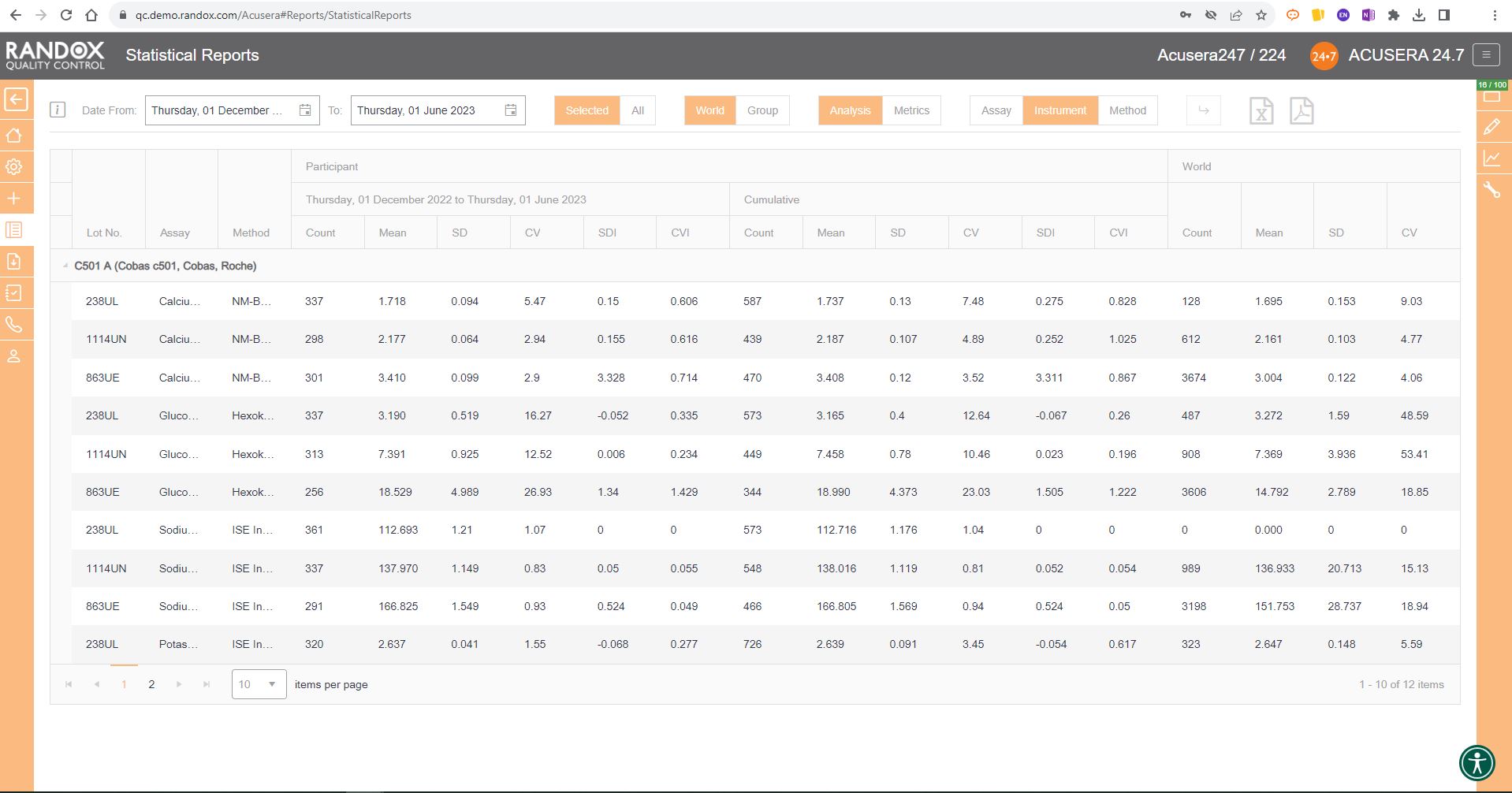
But in your case, time is the difference between a fast or delayed diagnosis for a patient.
This may impact their condition or treatment.
By making use of the suite of statistical options included in Acusera 24.7, including QC Multi-rules, 6Sigma and Uncertainty of Measurement, you can focus on providing the most accurate and efficient testing for patients.
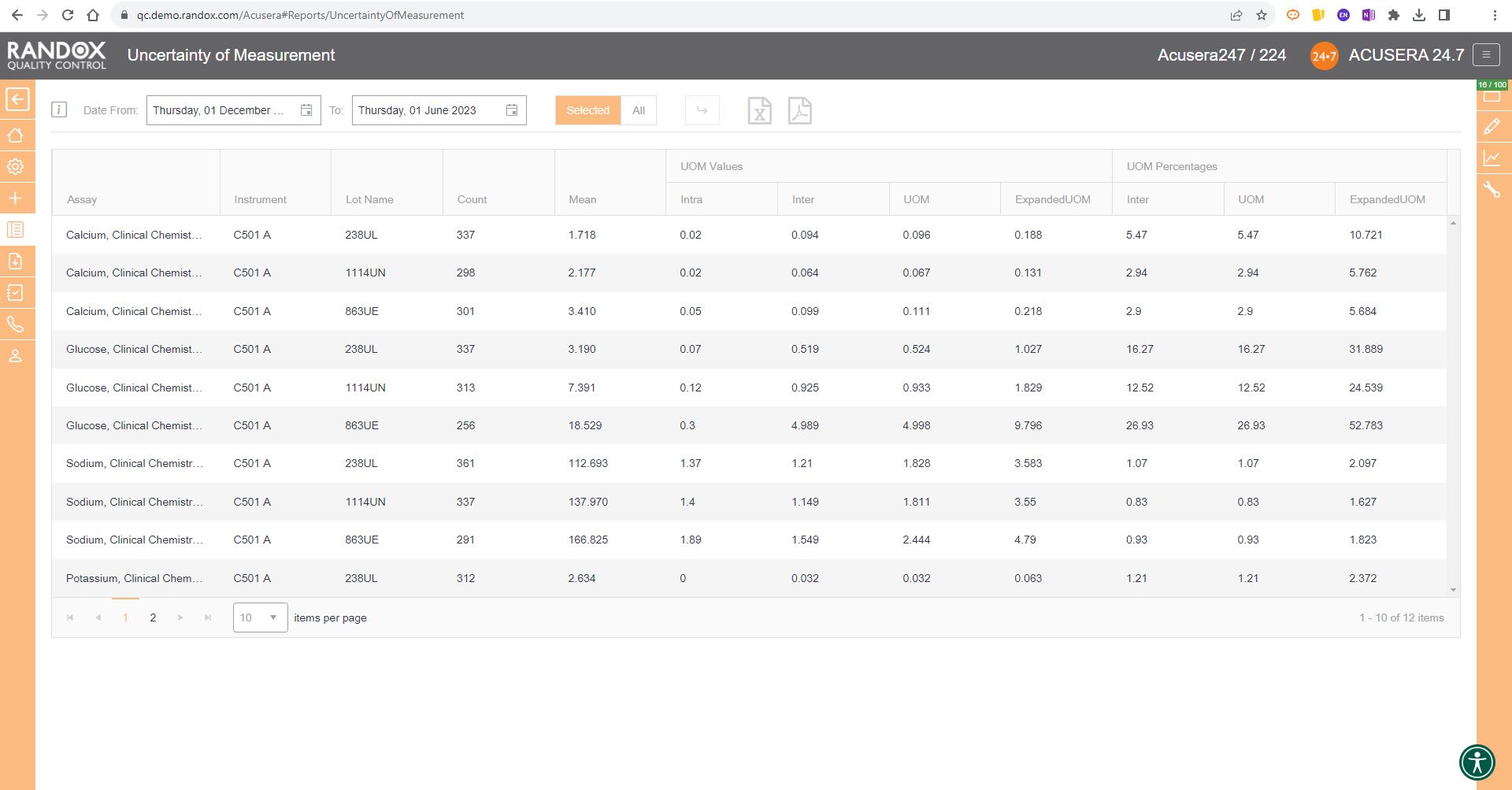
Data Entry
To save even more time, Acusera 24.7 can be integrated with many LIMS or Middleware packages for fully automated data transfer. At a predefined time, your internal software will send your QC data to a shared folder on your network and from there to a Randox Cloud IP address, meaning we don’t go into your IT system and take anything; we won’t cause any information security problems. This data is then taken from the cloud and populated onto 24.7.
All this in less time than it takes you to say, ‘fully automated data transfer.’
You can also import your data through a semi-automated upload procedure. For this, the data is exported from your LIMS or middleware and imported manually to your Acusera 24.7 account using an EDI import file. Simply put, all you have to do is send the file, and the software will populate it onto the system. Alternatively, you can upload the data manually on the simple and intuitive data entry page.
Acusera 24.7, while comprehensive and initially daunting due to its vast array of features, is incredibly easy to use. The Acusera 24.7 and QC operations teams are always eager to help new and existing Acusera 24.7 users with any issues they experience. We provide complete onboarding assistance and full training on the software for new customers while delivering prompt and effective customer support for existing users.
We’ve only begun to cover the range of features available on Acusera 24.7 for QC data management! For more information or to arrange a demo, get in touch with our team at marketing@randox.com. Or, you can take a look at our website here.

